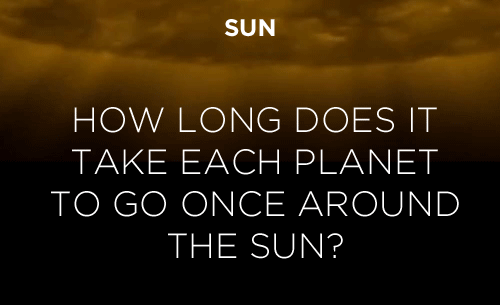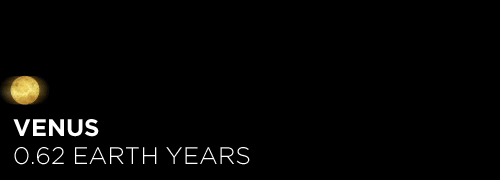The Hubble Space Telescope Just Sent Back A New Photo Of The Twin Jet Nebula. Here’s What It Looked
The Hubble Space telescope just sent back a new photo of the Twin Jet Nebula. Here’s what it looked like in 1997:

And now …

Whoa. But wait, we also got an updated image of the merging galaxies NGC 6240. What it looked like in 2008:

And today:

Science, you’re the best. Oh, and the explanation behind those merging galaxies and their black holes is wild.
More Posts from Night-hides-the-world and Others









Here’s the orbital period of our solar system’s 8 major planets (how long it takes each to travel around the sun). Their size is to scale and their speed is accurate relative to Earth’s. The repetition of each GIF is proportional to their orbital period. Mercury takes less than 3 months to zoom around Sol, Neptune takes nearly 165 years.
![A Multi-Camera 360° Panoramic Timelapse Of The Stars By Vincent Brady [VIDEO]](https://64.media.tumblr.com/4e12ed79b6fa93fbd2f17ccd004921d6/tumblr_n7h573O5RR1rte5gyo1_500.gif)
A Multi-Camera 360° Panoramic Timelapse of the Stars by Vincent Brady [VIDEO]
New Science from our Mission to Touch the Sun

In August 2018, our Parker Solar Probe mission launched to space, soon becoming the closest-ever spacecraft from the Sun. Now, scientists have announced their first discoveries from this exploration of our star!
The Sun may look calm to us here on Earth, but it’s an active star, unleashing powerful bursts of light, deluges of particles moving near the speed of light and billion-ton clouds of magnetized material. All of this activity can affect our technology here on Earth and in space.
Parker Solar Probe’s main science goals are to understand the physics that drive this activity — and its up-close look has given us a brand-new perspective. Here are a few highlights from what we’ve learned so far.
1. Surprising events in the solar wind
The Sun releases a continual outflow of magnetized material called the solar wind, which shapes space weather near Earth. Observed near Earth, the solar wind is a relatively uniform flow of plasma, with occasional turbulent tumbles. Closer to the solar wind’s source, Parker Solar Probe saw a much different picture: a complicated, active system.
One type of event in particular drew the eye of the science teams: flips in the direction of the magnetic field, which flows out from the Sun, embedded in the solar wind. These reversals — dubbed “switchbacks” — last anywhere from a few seconds to several minutes as they flow over Parker Solar Probe. During a switchback, the magnetic field whips back on itself until it is pointed almost directly back at the Sun.

The exact source of the switchbacks isn’t yet understood, but Parker Solar Probe’s measurements have allowed scientists to narrow down the possibilities — and observations from the mission’s 21 remaining solar flybys should help scientists better understand these events.
2. Seeing tiny particle events
The Sun can accelerate tiny electrons and ions into storms of energetic particles that rocket through the solar system at nearly the speed of light. These particles carry a lot of energy, so they can damage spacecraft electronics and even endanger astronauts, especially those in deep space, outside the protection of Earth’s magnetic field — and the short warning time for such particles makes them difficult to avoid.

Energetic particles from the Sun impact a detector on ESA & NASA’s SOHO satellite.
Parker Solar Probe’s energetic particle instruments have measured several never-before-seen events so small that all trace of them is lost before they reach Earth. These instruments have also measured a rare type of particle burst with a particularly high number of heavier elements — suggesting that both types of events may be more common than scientists previously thought.
3. Rotation of the solar wind
Near Earth, we see the solar wind flowing almost straight out from the Sun in all directions. But the Sun rotates as it releases the solar wind, and before it breaks free, the wind spins along in sync with the Sun’s surface. For the first time, Parker was able to observe the solar wind while it was still rotating – starting more than 20 million miles from the Sun.

The strength of the circulation was stronger than many scientists had predicted, but it also transitioned more quickly than predicted to an outward flow, which helps mask the effects of that fast rotation from the vantage point where we usually see them from, near Earth, about 93 million miles away. Understanding this transition point in the solar wind is key to helping us understand how the Sun sheds energy, with implications for the lifecycles of stars and the formation of protoplanetary disks.
4. Hints of a dust-free zone
Parker also saw the first direct evidence of dust starting to thin out near the Sun – an effect that has been theorized for nearly a century, but has been impossible to measure until now. Space is awash in dust, the cosmic crumbs of collisions that formed planets, asteroids, comets and other celestial bodies billions of years ago. Scientists have long suspected that, close to the Sun, this dust would be heated to high temperatures by powerful sunlight, turning it into a gas and creating a dust-free region around the Sun.

For the first time, Parker’s imagers saw the cosmic dust begin to thin out a little over 7 million miles from the Sun. This decrease in dust continues steadily to the current limits of Parker Solar Probe’s instruments, measurements at a little over 4 million miles from the Sun. At that rate of thinning, scientists expect to see a truly dust-free zone starting a little more than 2-3 million miles from the Sun — meaning the spacecraft could observe the dust-free zone as early as 2020, when its sixth flyby of the Sun will carry it closer to our star than ever before.
These are just a few of Parker Solar Probe’s first discoveries, and there’s plenty more science to come throughout the mission! For the latest on our Sun, follow @NASASun on Twitter and NASA Sun Science on Facebook.






Time for another out of this world comic for starry cosmos month!
This week’s entry, “Gamma Ray Bursts”
http://imagine.gsfc.nasa.gov/science/objects/bursts1.html
http://earthsky.org/space/gamma-ray-bursts-are-the-most-powerful-explosions-in-the-universe

NASA’s Parker Solar Probe Spies Newly-Discovered Comet NEOWISE by NASA’s Marshall Space Flight Center
A universe in motion seen from the International Space Station during a night pass over Earth.
(@ wonderofscience on Twitter)
Timelapse created from images courtesy of the Earth Science and Remote Sensing Unit, NASA Johnson Space Center(ISS061-E-110520-111341 eol.jsc.nasa.gov).

“The shockwave from a 20,000 year-old supernova explosion in the constellation of Cygnus is still expanding into interstellar space. The collision of this fast moving wall of gas with a stationary cloud has heated it causing it to glow in visible as well as high energy radiation, producing the nebula known as the Cygnus Loop (NGC 6960/95). The nebula is located a mere 1,400 light-years away. The colors used here indicate emission from different kinds of atoms excited by the shock: oxygen-blue, sulfur-red, and hydrogen-green. This picture was taken with the Wide Field and Planetary Camera 2 on board the Hubble Space Telescope.”
Photo by J Hester of ASU, description via NASA.
The #HubbleTelescope captured these auroras on #jupiter caused by light waves interacting with the planet’s magnetic fields.
-
 furiouschaoscat liked this · 1 year ago
furiouschaoscat liked this · 1 year ago -
 lemwimsen reblogged this · 1 year ago
lemwimsen reblogged this · 1 year ago -
 lemwimsen liked this · 1 year ago
lemwimsen liked this · 1 year ago -
 indiefoxproductions reblogged this · 1 year ago
indiefoxproductions reblogged this · 1 year ago -
 skyramamve liked this · 1 year ago
skyramamve liked this · 1 year ago -
 morghiesart liked this · 1 year ago
morghiesart liked this · 1 year ago -
 holtizicont liked this · 1 year ago
holtizicont liked this · 1 year ago -
 cappybaras liked this · 1 year ago
cappybaras liked this · 1 year ago -
 stringsbean reblogged this · 1 year ago
stringsbean reblogged this · 1 year ago -
 colorpatch reblogged this · 2 years ago
colorpatch reblogged this · 2 years ago -
 barbaraannprior reblogged this · 2 years ago
barbaraannprior reblogged this · 2 years ago -
 kebabista liked this · 2 years ago
kebabista liked this · 2 years ago -
 pfannkuchendammerung reblogged this · 2 years ago
pfannkuchendammerung reblogged this · 2 years ago -
 bat-zilla reblogged this · 2 years ago
bat-zilla reblogged this · 2 years ago -
 starfilm reblogged this · 2 years ago
starfilm reblogged this · 2 years ago -
 starfilm liked this · 2 years ago
starfilm liked this · 2 years ago -
 crynwr-drwg reblogged this · 2 years ago
crynwr-drwg reblogged this · 2 years ago -
 datsparklez reblogged this · 2 years ago
datsparklez reblogged this · 2 years ago -
 maqqy96 reblogged this · 2 years ago
maqqy96 reblogged this · 2 years ago -
 drzephyr liked this · 2 years ago
drzephyr liked this · 2 years ago -
 asiandutchgirl reblogged this · 2 years ago
asiandutchgirl reblogged this · 2 years ago -
 coolricoolatta reblogged this · 2 years ago
coolricoolatta reblogged this · 2 years ago -
 25coriandah liked this · 2 years ago
25coriandah liked this · 2 years ago -
 toofewtrueblue reblogged this · 2 years ago
toofewtrueblue reblogged this · 2 years ago -
 toofewtrueblue liked this · 2 years ago
toofewtrueblue liked this · 2 years ago -
 nerine-in-bloom liked this · 2 years ago
nerine-in-bloom liked this · 2 years ago -
 ohsugar-ohhoney liked this · 2 years ago
ohsugar-ohhoney liked this · 2 years ago -
 girltwinkcn reblogged this · 2 years ago
girltwinkcn reblogged this · 2 years ago -
 girltwinkcn liked this · 2 years ago
girltwinkcn liked this · 2 years ago -
 paopujuice reblogged this · 2 years ago
paopujuice reblogged this · 2 years ago -
 paopujuice liked this · 2 years ago
paopujuice liked this · 2 years ago -
 smalllemonade liked this · 2 years ago
smalllemonade liked this · 2 years ago -
 lady3li liked this · 2 years ago
lady3li liked this · 2 years ago -
 nekogorogoro reblogged this · 2 years ago
nekogorogoro reblogged this · 2 years ago -
 carryonwaywardangel reblogged this · 2 years ago
carryonwaywardangel reblogged this · 2 years ago -
 crynwr-drwg liked this · 2 years ago
crynwr-drwg liked this · 2 years ago -
 cardinalfeng reblogged this · 2 years ago
cardinalfeng reblogged this · 2 years ago -
 clonebutchblues reblogged this · 2 years ago
clonebutchblues reblogged this · 2 years ago -
 kgoblin reblogged this · 2 years ago
kgoblin reblogged this · 2 years ago -
 kgoblin liked this · 2 years ago
kgoblin liked this · 2 years ago -
 soilrockslove liked this · 2 years ago
soilrockslove liked this · 2 years ago -
 infinitelines liked this · 2 years ago
infinitelines liked this · 2 years ago
Astronomy and the other wonders you witness when you look to the skies.
115 posts

